Let me paint you a picture for a moment (nothing whimsical, I promise). Imagine you are parked somewhere deep in the Icelandic countryside.
You have just cooked a pot of pasta in your campervan kitchen (Italians look away).
The wind taps on the side of the camper like an impatient friend.
You step outside into the crisp night air.
Above you, a swirl of faintly green light starts to unfurl as if someone is slowly peeling open the sky, with more colours from pinks to purples (reds and blues if you’re super lucky) start to appear.
That is the Northern Lights in Iceland, in a nutshell. Well, we provide the campervan experience, and you’ll take care of the nightly wonder. It is a moment you will replay for years.
You want to know when you can see them. You also want the best way to chase them without freezing on a roadside while a tour bus drives away.
This guide gives you the timing, the science, the places, and the plan. It also shows why a campervan gives you the single biggest advantage for aurora hunting in Iceland, with some lesser-known tips along the way based on my real experience from every aurora season (and I’m a huge Northern Lights nerd with over 10k photos).
Bring your sense of adventure and a warm hat. And, I’ll help you with everything else so you can enjoy watching the greatest show on Earth the best way possible.
The Best Time of Year to See the Northern Lights in Iceland

Timing is everything when it comes to spotting the aurora. This is not just about picking a random week in winter and hoping for the best; it is about understanding Iceland’s seasonal rhythms and how they affect your chances.
From the length of night to the clarity of the air, each part of the year changes the way the lights appear, from black, darkened winter skies to the blue hues found in late August. Travelling in the right season also means enjoying Iceland’s other winter magic, from ice caves to snowy waterfalls, all of which are easy to weave into your route when you have the freedom of a campervan.
Prime Northern Lights Season: September to April
The main aurora season in Iceland runs from September to April. This is when the nights are dark enough for the sky to act as a proper stage.
In summer, the lights can still occur, but the night never gets truly dark, so you will not see them unless you know how to transform into a UV light-seeing reindeer.
Autumn ushers in long evenings, and by winter, you have enough darkness for hours of potential aurora viewing.
Happy Campers’ winter campervan rentals are built for these months, with heaters, insulated interiors, and snow-ready tyres so you can go aurora chasing in comfort (just don’t drive like a madman, Aurora hunting is not Fast and Furious 11).
Why Winter Months Offer the Best Chance
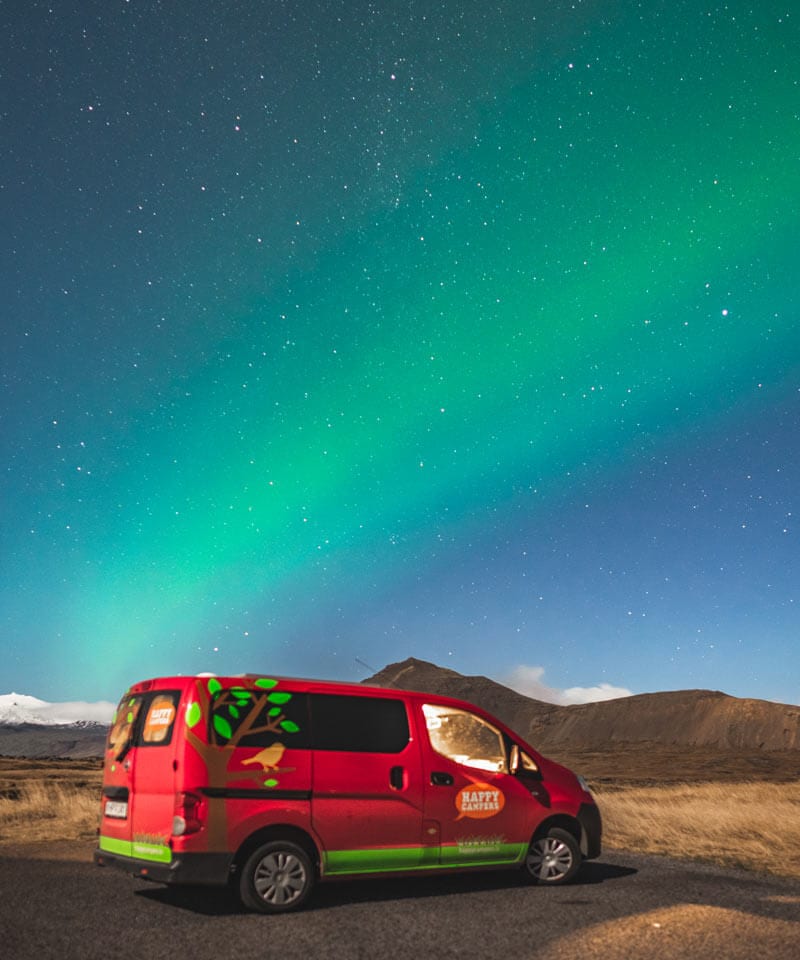
October to March gives you the longest nights. In December, you can have more than 20 hours of darkness, offering plenty of time for a show with multiple sub-storm events if the solar activity is playing ball (when the skies go crazy with colour during the expansion phase). The air is also crisper, meaning less moisture and clearer skies.
Yes, it is colder, but that is where a heated campervan becomes your warm little base camp (you’re welcome, guys!) While tour buses leave after their allotted hours (usually far too early in the night, in my opinion), you can stick around until the aurora turns up, over and over again, without another 9 people demanding a toilet stop.
The Russell–McPherron Effect: Why Equinoxes Boost Your Chances

The Russell–McPherron effect explains why aurora activity often peaks around the equinoxes, late September and late March (and, no, it’s nothing spiritual or pagan).
It is about the tilt of the Earth and how the solar wind interacts with our magnetic field. In short, around the equinoxes, the geometry is just right for more charged particles to sneak into our atmosphere and light up the skies.
Translation: if you book your Iceland road trip around these months, you have physics on your side. Also, these months (known as the ‘shoulder season’ here in Iceland) offer a greater balance of light, a lower frequency of storms, and warmer temperatures, which is why we recommend it as the ‘Goldilocks travel time’ for Northern Lights hunters.
Chasing the Aurora From the Comfort of a Campervan
Aurora hunting is a patient waiting game (not always, but often).
You might get a spectacular display within minutes, or you might be out there for hours.
In a campervan, “waiting” means sipping hot chocolate, charging your camera, and staying warm until someone yells, “They are out!” You could even take it in shifts, sleeping if you’re intent on not missing a moment.
With our flexible itineraries, you can move to wherever the forecast looks best instead of being stuck at a hotel under cloudy skies.
Best Time of Night for Northern Lights Viewing in Iceland
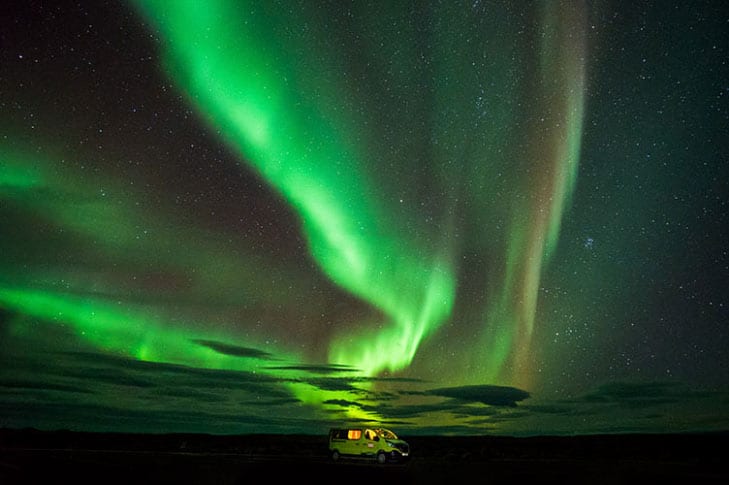
Knowing when to be outside is just as important as knowing where to go. The Northern Lights are unpredictable, but there are certain hours when your chances naturally increase (in my experience, focus on 11pm and 1am). Nightfall in Iceland changes dramatically through the seasons, so being aware of the shift from civil to astronomical twilight will help you plan.
Travelling by campervan means you can easily adjust your schedule, take a nap during the day, and be ready to set up in the perfect spot when darkness arrives.
Peak Hours for Aurora Activity
The best hours are generally between 9 pm and 2 am, when the aurora oval (the zone where activity is strongest) often passes directly over Iceland. During this period, the combination of darkness, atmospheric stability, and geomagnetic activity gives you the highest probability of a sighting.
However, nature is unpredictable, so avoid watching the clock too rigidly. The lights can make surprise appearances earlier in the evening, or sometimes linger towards dawn, especially during periods of heightened solar activity. Having a campervan ready means you can adjust in real time, whether that means setting up early, waiting it out, or staying put for a potential late-night finale.
Best Times for Photographers to Capture the Aurora

For photography, aim for the first few hours after astronomical twilight, when the sky is truly dark but before fatigue sets in and temperatures drop further (unless you’re the undisputed night owl of the north). This window often delivers the richest colours and the most defined shapes in your shots (11pm is always my luckiest time of seeing the best displays).
Photographers also value nights with a faint moon, which can illuminate the foreground in colder blue tones, whether it’s a glacier, lava field, or your own parked campervan, without overpowering the aurora’s glow.
Plan your composition in advance, scout your location during daylight, and keep extra batteries warm inside your jacket to avoid power loss in the cold. Our photography tips guide covers everything from camera settings to creative framing ideas, helping you capture unforgettable long-exposure shots from the comfort of your van’s doorstep.
In short, you’ll want a DSLR camera (full frame is better), a wide-angle lens, and a tripod. Anything else, like a red light torch, is a bonus.
How to Use Aurora Forecasts to Plan Your Night
The Icelandic Met Office updates its aurora forecast daily, showing detailed cloud cover maps and the KP index, which measures aurora strength on a scale from 0 to 9. Understanding these readings can make the difference between a wasted trip and a front-row seat to the show.
A higher KP index means a stronger display, while the cloud map tells you exactly where skies are the clearest (if you have full cloud cover, there will be no aurora sightings for you in that location). Check both before you set off, then adjust your route to maximise your chances.
If clouds are gathering in the south, head north, or if a clear patch opens up along the coast, make it your destination. That is the beauty of vanlife, it offers you the ability to respond instantly to changing conditions, maximising your chances of seeing the lights in their full glory.
Stay Flexible With a Campervan for Maximum Viewing

Tour groups stick to fixed schedules, which can mean heading back to base even when the sky starts to clear. In a campervan, you have the freedom to keep going, whether that means driving another 30 minutes to slip past cloud cover or finding an even darker location for better visibility.
You can pause wherever the conditions look promising, stay as long as you like, and even change your plan mid-journey. When the aurora appears at 1am, you are already in place with your camera ready, a warm drink in hand, and no rush to leave. And, why not sky watch from the comfort of your cozy sleeping bag?
How Weather and Light Conditions Affect Northern Lights Visibility
When it comes to aurora chasing, the weather forecast is just as important as the aurora forecast. Wind direction, humidity, and even recent snowfall can influence how clearly the lights appear.
Travelling in a campervan gives you the freedom to adapt to these changes in real time, heading towards clearer skies or drier conditions at a moment’s notice (avoiding those winter snowstorms as best as possible). The right mix of darkness, cloud-free skies, and crisp air can turn a faint glow into one of the best spectacles of your life.
The Importance of Clear Skies

Even the most active aurora cannot shine through thick clouds, making cloud cover the single biggest obstacle to your viewing success (yes, we all hate clouds). Localised weather patterns in Iceland can change rapidly, with one valley shrouded in mist while the next is perfectly clear.
This is why mobility is your greatest asset. With a campervan, you can check updated satellite images, follow real-time weather alerts, and make quick decisions to head for clearer skies on the night. It allows you to react within minutes, turning what could have been a disappointing evening into an unforgettable night under a cloudless, glowing sky.
Escaping Light Pollution With a Campervan
Artificial light dulls the colours and intensity of the aurora, washing out the greens and reds until they lose their magic. To experience the lights in their full vibrancy, you need to be far from towns, streetlights, and any other sources of light pollution.
Iceland offers countless rural and wilderness locations where the sky remains untouched by artificial glow, and with a campervan, you can reach them easily. Park in complete darkness, let your eyes adjust for at least 20 minutes, and you will notice the lights becoming sharper, brighter, and more dynamic against the deep black of the night sky.
Even if you have no Northern Lights sightings, you’ll likely see a full canvas of stars you’ve never seen before, including the famous Milky Way band at the right times of year.
Why Iceland’s Remote Countryside Is Perfect for Aurora Hunting
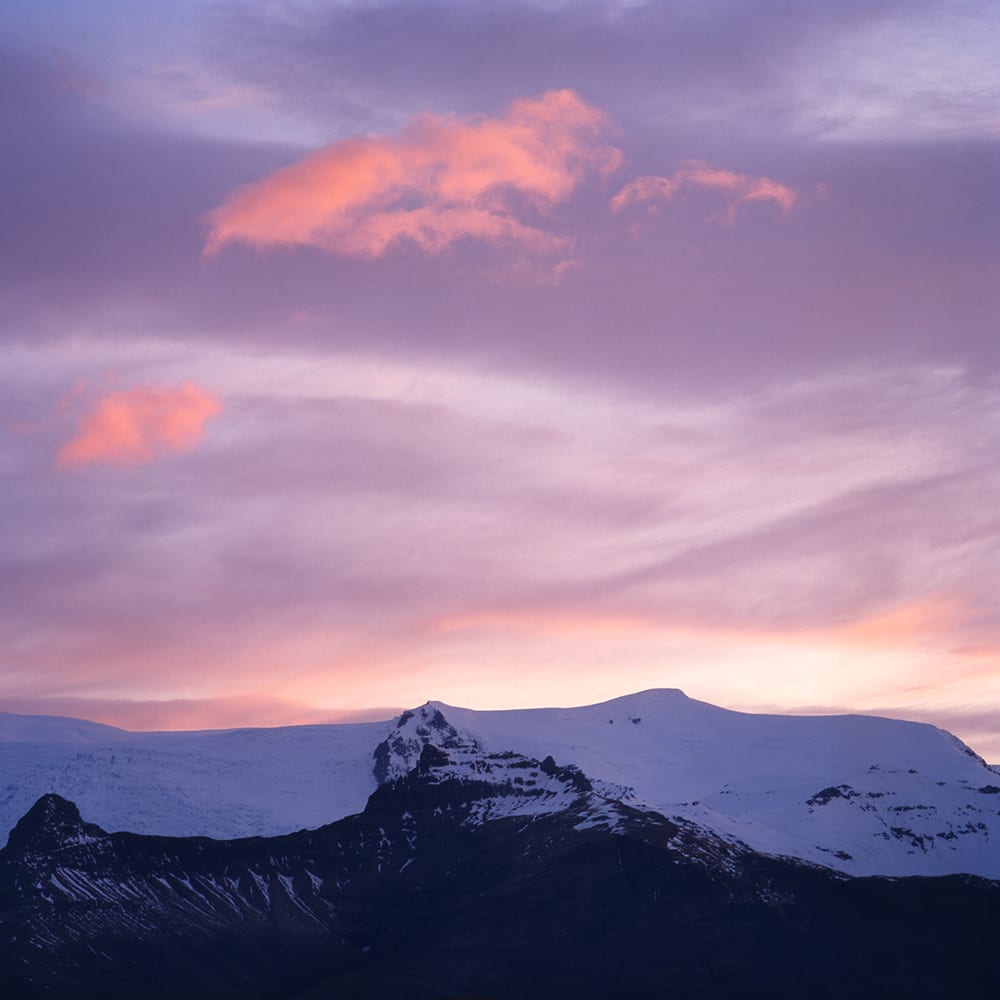 Pink skies at night in Skaftafell
Pink skies at night in Skaftafell
Iceland’s sparse population makes it one of the easiest places in the world to find truly dark-sky areas, far removed from the glow of artificial lights. From dramatic fjords and windswept lava fields to the valleys of glacial tongues and remote black-sand beaches, the country offers countless natural stages where the aurora can perform without distraction (a good remedy to celestial stage fright, I’m sure you’ll agree).
Travelling by campervan means you can not only reach these locations with ease but also settle in for the night, giving yourself the chance to witness multiple displays without the need to rush back to a hotel or navigate dark, icy roads at the end of the evening.
Best Places to See the Northern Lights in Iceland
Iceland is full of locations where the landscape and the night sky seem designed for each other. The country’s varied terrain means you can frame the aurora over a variety of glaciers, waterfalls, volcanic peaks, or just vast stretches of untouched coastline with jagged rock formations (maybe trolls) just offshore.
Choosing the right viewing spot is about more than just the lack of light pollution; it’s about finding a place where you can settle in, enjoy the view, and be ready when the show begins.
Famous Northern Lights Hotspots
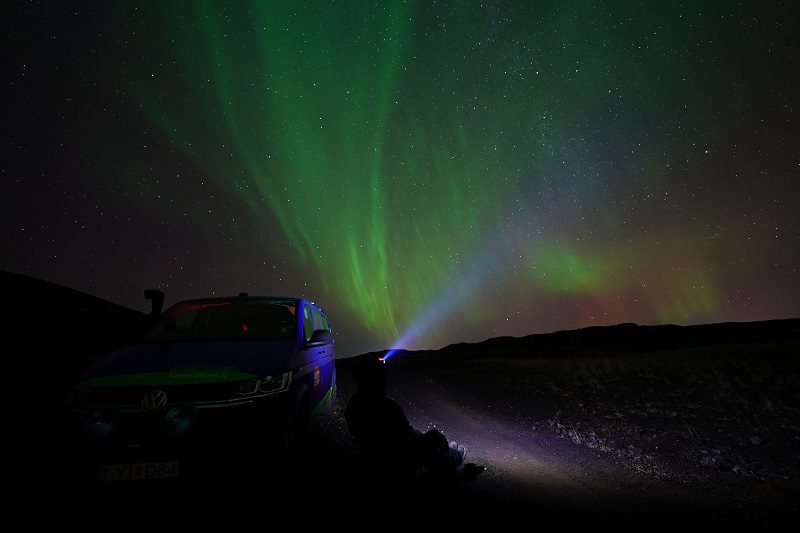
Popular locations include Thingvellir National Park, where you can directly stand between tectonic plates under a shimmering sky (you can get a perfect reflection if you position your camera by the Silfra fissure); the Jokulsarlon Glacier Lagoon, where glowing icebergs drift beneath the aurora; and the Snaefellsnes Peninsula, often called “Iceland in Miniature” for its variety of dramatic scenery (the classic shots of Kirkjufell framed just behind the Kikjufellfoss waterfall is a popular location).
These spots offer not only minimal light pollution but also unique natural features that create striking backdrops for aurora photography. Visiting them in a campervan means you can arrive early to claim the best vantage points, explore nearby attractions in daylight, and settle in for the night without the need to rush back to town. Set your camera up early in these locations as they can get popular (for good reason!)
Discover Hidden Viewing Gems With Campervan Freedom

Beyond the well-known spots, a campervan allows you to explore hidden gems like isolated fjords where the water mirrors the colours above when the winds stay calm, remote beaches where waves crash under dancing lights, and mountainous regions that feel like the top of the world.
These places are often inaccessible or impractical for large tour groups, meaning you can enjoy them without the crowds. Some of the most spectacular displays happen in these off-the-map locations, where the only company might be the sound of the wind and the glow of the aurora stretching from one horizon to the other.
Also, there is a rare phenomenon whereby the Northern Lights have been known on occasion to create sounds resembling clapping, which is so surreal and incredible when you have a lot of privacy.
Parking Overnight in Scenic Aurora Locations
With your own campervan, you can park overnight in designated camping areas that offer uninterrupted views of the night sky, often in locations surrounded by Iceland’s most stunning natural scenery. Arriving in daylight allows you to pick a prime spot with a clear horizon to the north (they’re called the Northern Lights for a reason), set up your gear, and settle in comfortably.
The Stories and Folklore of the Northern Lights in Iceland
For centuries, Icelanders have looked up at the night sky and woven tales about the shifting colours above. These legends, passed down through generations, give the aurora a cultural depth that adds to its natural wonder (as well as giving you some chat whilst you wait for them to pop out).
As you travel, these stories become conversation starters and campfire moments for your further travels around the world, bringing a sense of connection to the people who have lived with this phenomenon for hundreds of years to those who have never seen it. Hearing them while you wait in your campervan for the first brightening green streak to appear adds an extra layer of magic to the experience.
Viking Beliefs About the Aurora
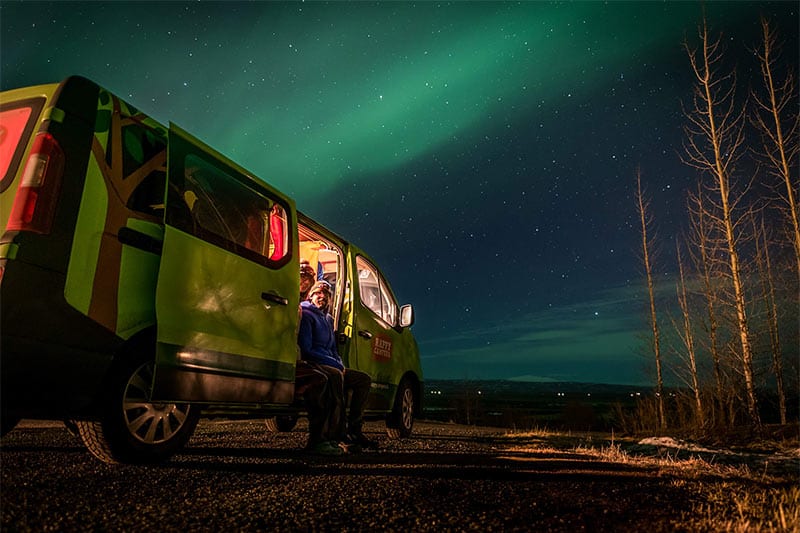
Norse mythology tells of the aurora as the shimmering reflections from the polished shields and armour of the Valkyries, the warrior maidens who rode across the night sky, guiding fallen heroes to Valhalla (probably where Chris Hemsworth will end up). These lights were seen as a bridge between the mortal world and the realm of the gods, a celestial procession honouring bravery and heroism.
Tales From Icelandic Sagas
Some sagas describe the lights as powerful omens, with their meaning shifting depending on the colour, movement, and intensity of the display. A calm, steady glow might be read as a sign of prosperity or a successful season ahead, while fast-moving, fiery streaks could be taken as warnings of upcoming hardship or significant change. These interpretations added drama and meaning to every sighting, making the Northern Lights not just a natural wonder but a deeply personal and cultural experience for those who witnessed them.
Myths You Can Share Around the Campervan Heater
One Icelandic belief claimed the lights would ease the pain of childbirth (for any mothers out there, think of this as the ancient epidural), but only if the mother avoided looking directly at them, as doing so was thought to risk bad luck or complications.
It’s the kind of tale that blends superstition with hope, showing how the aurora was woven into daily life and personal milestones.
Sharing legends like this while you wait in the quiet of an Icelandic wintry night adds texture to the experience, making your aurora hunt feel like part of a much older story that has been told under these same skies for centuries (and preferably not to a modern-day woman midway through an excruciating labour!)
Why a Campervan Is the Best Way to See the Northern Lights in Iceland
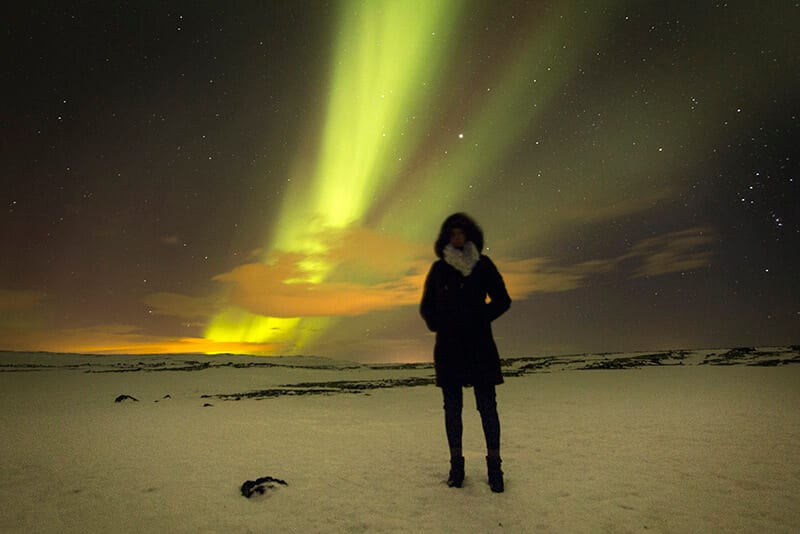
When you are chasing a phenomenon as elusive as the Northern Lights, flexibility and comfort become your greatest assets. Fortunately (and I know, I would say this), a campervan blends both, giving you the ability to head wherever the skies are clearest and to do so without sacrificing warmth or convenience.
It means no fixed itineraries, no rushing back to accommodation, and no missing out because the best activity happened outside the hours of a scheduled tour (this is your holiday, it should always be on your terms). It turns every night into an opportunity and every location into a potential front-row seat to one of nature’s most spectacular shows.
Move With the Weather for the Best Chances
A campervan lets you follow clear skies wherever they appear, using real-time weather and aurora forecasts to guide your route. This mobility means you can leave cloudy conditions behind, seek out the best dark-sky locations, and position yourself exactly where the aurora is most likely to be visible (or at least, what the forecasts are suggesting). It turns unpredictable weather into an advantage, as every change in conditions becomes an opportunity to improve your chances of that truly once-in-a-lifetime sighting.
Warm and Cozy While Waiting for the Aurora
With heating to keep you warm through the coldest hours, soft bedding for resting between sky checks, and a fully equipped kitchen for hot drinks and midnight snacks, you can easily stay comfortable and self-sufficient while you wait (there’s nothing worse than a cold and hangry wait). This means you can enjoy the experience without shivering in the open or cutting your viewing short, and you are ready to spring into action the moment the lights begin to dance. Whether you also dance or not is totally optional.
Combine Sightseeing and Aurora Chasing in One Trip
Your trip is not limited to nighttime aurora hunting. In the daytime, you can explore Iceland’s incredible natural attractions, from the thundering waterfalls like Skógafoss and Gullfoss to towering glaciers of South Iceland, and dramatic volcanic landscapes dotted with craters and lava fields. Travelling by campervan means you can weave these sights into your route with ease, stopping whenever a view takes your breath away, and making the most of every daylight hour before settling in for another night under the stars.
Happy Campers Winter Campervan Options for Northern Lights Chasing

Winter in Iceland can be fierce, but it is also when the island reveals some of its most unique sights, including the Northern Lights at their best. Choosing the right campervan for the season is the difference between an uncomfortable, rushed trip and a cosy, flexible adventure. Our winter-ready fleet is designed to handle icy roads, cold nights, long stretches of darkness, and with facilities to keep any grumpy, hungry fights at bay (crucial if you’re married).
Heated Campervans for Winter Comfort
All winter vans come with powerful heaters to keep you warm even during sub-zero nights, thick insulation to lock in the heat, and winter tyres for safe handling on icy or snow-covered roads (which can, and will, change daily). This combination ensures you can travel confidently across Iceland’s varied winter terrain, stay comfortable while waiting for the aurora, and wake up ready for another day of adventure regardless of the weather.
Planning Your Northern Lights Road Trip in Iceland
Organising a Northern Lights trip in Iceland is about crafting an itinerary that balances flexibility with comfort, and leaves room for spontaneous detours when the aurora forecast looks too promising not to take that extra couple of hours drive for.
Travelling in a campervan gives you the freedom to shape your days and nights around changing conditions, so you can chase the best skies without missing out on Iceland’s other natural wonders. And though we cannot promise you’ll see the Northern Lights, we can set you up for success.
Suggested Itineraries for Aurora Hunters
Follow our custom routes that combine prime aurora locations with must-see attractions, carefully designed to maximise both your chances of seeing the Northern Lights and your enjoyment of Iceland’s diverse landscapes.
These itineraries factor in seasonal daylight hours, typical weather patterns, and proximity to campsites, so you can plan your days around everything from hot springs like Reykjadalur to Geysir and beyond, with your nights around the most promising aurora viewing spots. With a campervan, you can adapt these routes in real time, taking advantage of clear skies or a sudden burst of solar activity without missing out on other highlights. You can chase that coronal mass ejection that dominates your Facebook feed on a moment’s notice.
Safety Tips for Winter Driving in Iceland
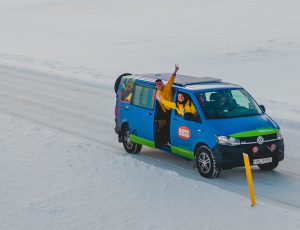
Check road conditions daily and pay close attention to regional forecasts, as conditions can vary dramatically between areas. Be prepared for sudden weather changes, especially in winter, by carrying essentials such as extra clothing, food, and water, and make sure to fuel up when you can when venturing further into the sticks. Being ready with alternative routes and safe pull-off points can make all the difference if a storm rolls in or a road closes unexpectedly.
Essential Gear to Pack for a Northern Lights Trip
In short, I highly recommend you come prepared with the following, as buying camera accessories in Reykjavík is both highly limited and almost certainly more expensive:
- Thermal layers to keep you warm in sub-zero temperatures.
- A sturdy camera tripod for crisp long-exposure shots.
- Extra camera batteries kept warm inside your clothing to prevent power loss.
- A headlamp with red-light mode to preserve night vision.
- Plenty of high-energy snacks and hot drinks to keep you going through long, cold nights outside.
Can You See the Northern Lights in Summer?
No, the midnight sun keeps the sky too bright for the aurora to be visible, as even at midnigh, the sky remains lit like daytime (don’t worry, there are blinds in your camper to avoid that insomnia).
From late May to early August, Iceland experiences continuous daylight, which means you will not see the Northern Lights during this period. If witnessing the aurora is your priority, plan your trip outside of the summer months when darkness returns and the conditions for viewing improve dramatically.
How Long Do the Northern Lights Last?
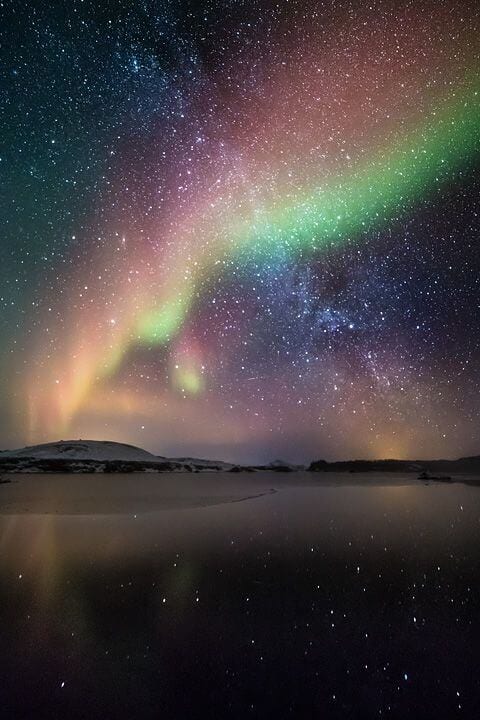
Displays can last from none at all to a few minutes, to several hours, depending on activity levels and the strength of the geomagnetic storm driving them. Short bursts often happen during quieter conditions, while stronger solar events can produce sustained shows that ebb and flow through the night (these are the most fun, but massively impact your sleep if you get my level of FOMO).
It’s worth staying outside or keeping watch from your campervan for multiple peaks, as the aurora can fade and then return unexpectedly, offering several opportunities for incredible photos and memories in a single night.
After all, nothing worth having came easy. So, when you’re tired of waiting and your patience is wearing thin, if you’ve come in winter, have clear skies, and are looking north, push through (I often take a couple of extra-long exposures to see if the camera is picking up anything faint that my eyes can’t yet see).
Are the Northern Lights Guaranteed?
No, they depend on solar activity and clear skies, so there is never a 100% guarantee (if there was, we’d all be a lot richer). Solar flares and geomagnetic storms vary from week to week, and even on high-activity nights, cloud cover can block your view entirely, which is by far the most infuriating outcome.
That is why planning in winter (when the nights are longest and the air is often clearer) gives you the best odds. Combine this with monitoring aurora forecasts, staying mobile to chase clear skies, and allowing several nights in your itinerary, and you will maximise your chances of witnessing an unforgettable display (and I’d love to hear about your stories – successes and struggles, as that is part of the Iceland experience).
Final Thoughts: Make Your Northern Lights Trip Unforgettable
Seeing the Northern Lights in Iceland is one of those rare bucket list moments that lives up to the hype, and then some. With a campervan, you decide where to go, how long to linger, and exactly how you want to experience it.
You can chase clear skies across the island, brew a hot drink while you wait, and roll straight into bed under your layers and sleeping bag when the show ends. Combine the thrill of the hunt with the comfort of your own mobile base, and you have the ultimate aurora adventure. It’s the kind of adventure you will talk about for years, smugly sharing your awesome snaps with your friends who went to bed that extra minute early (be patient!)
Back